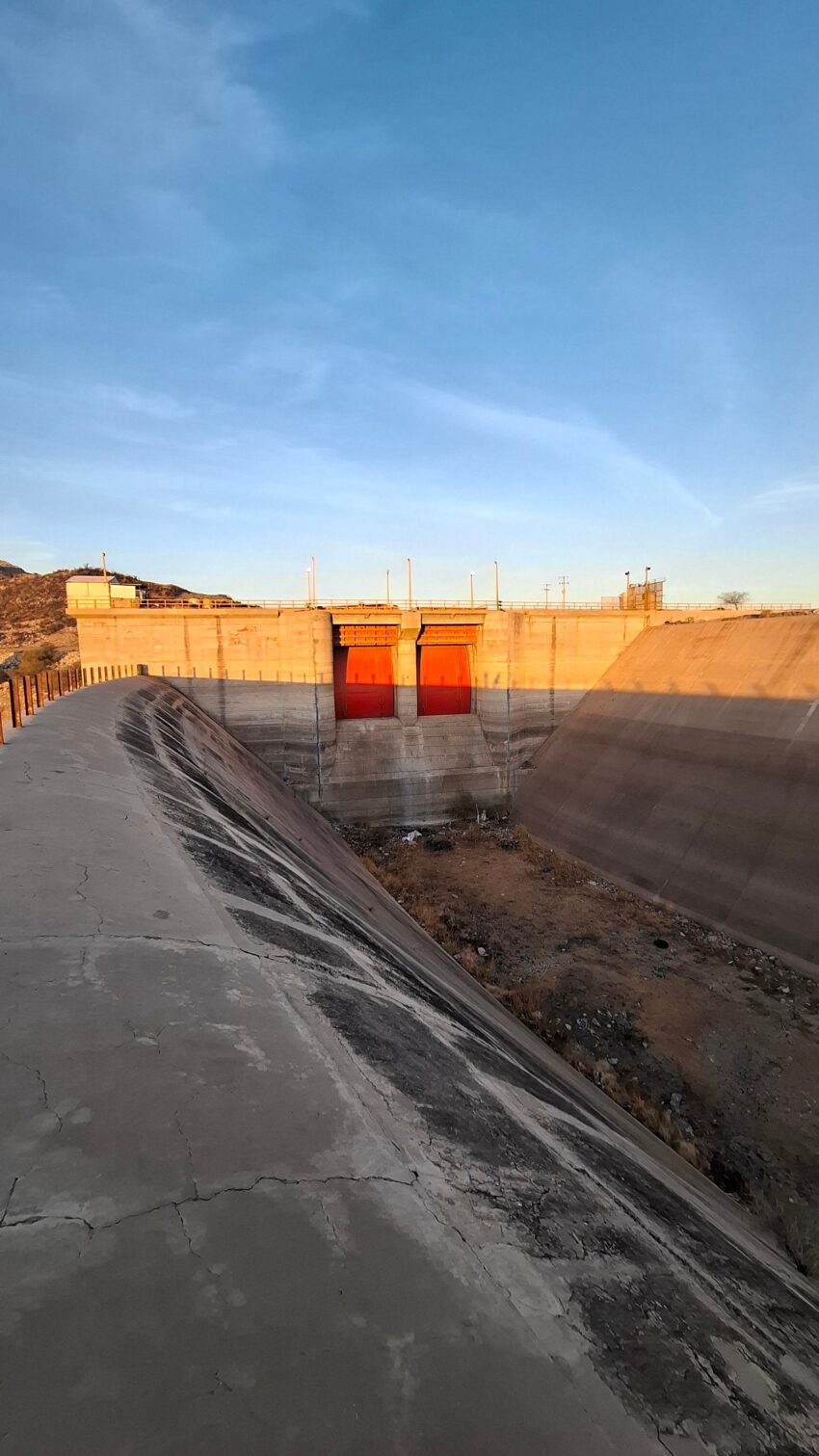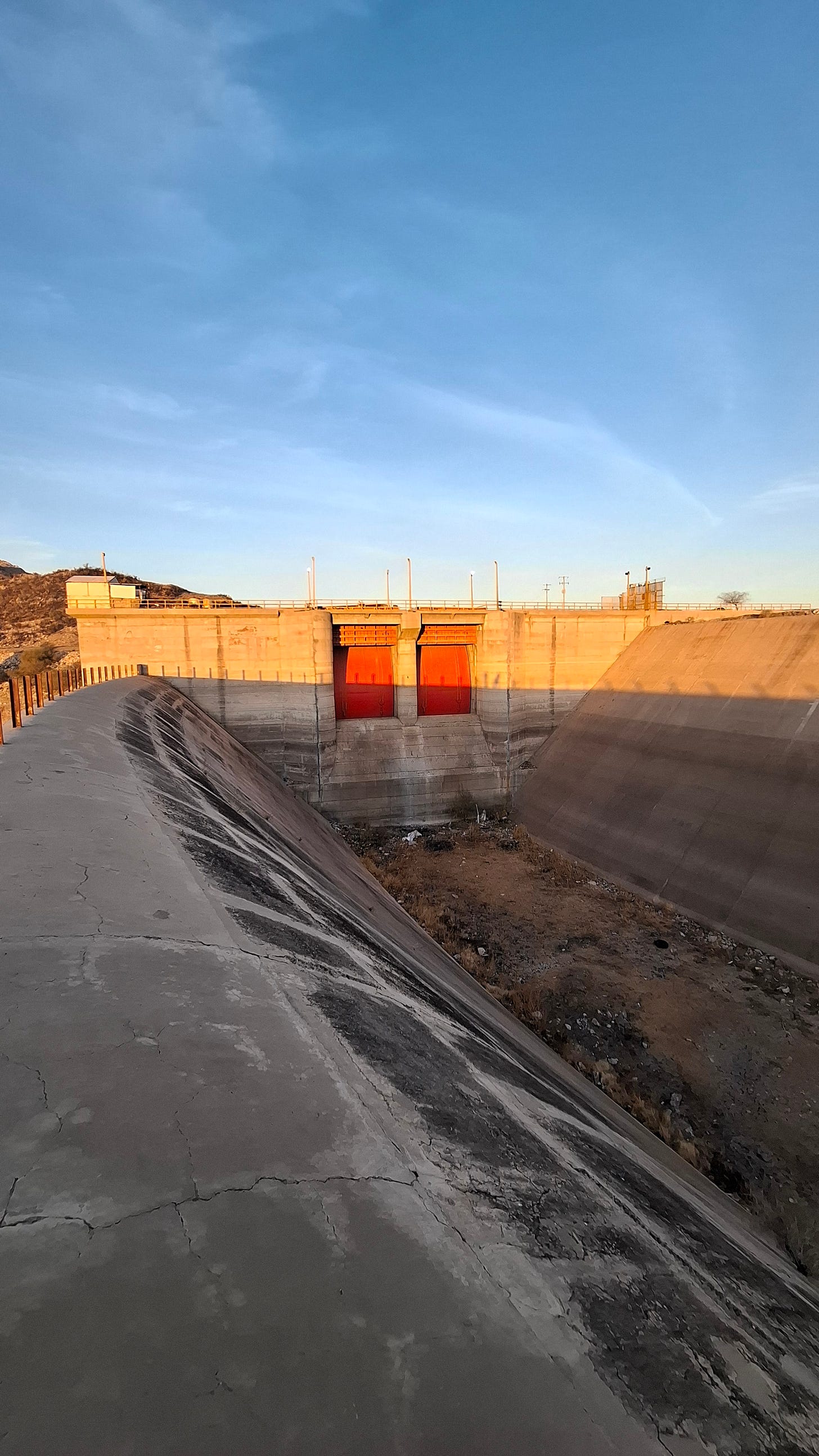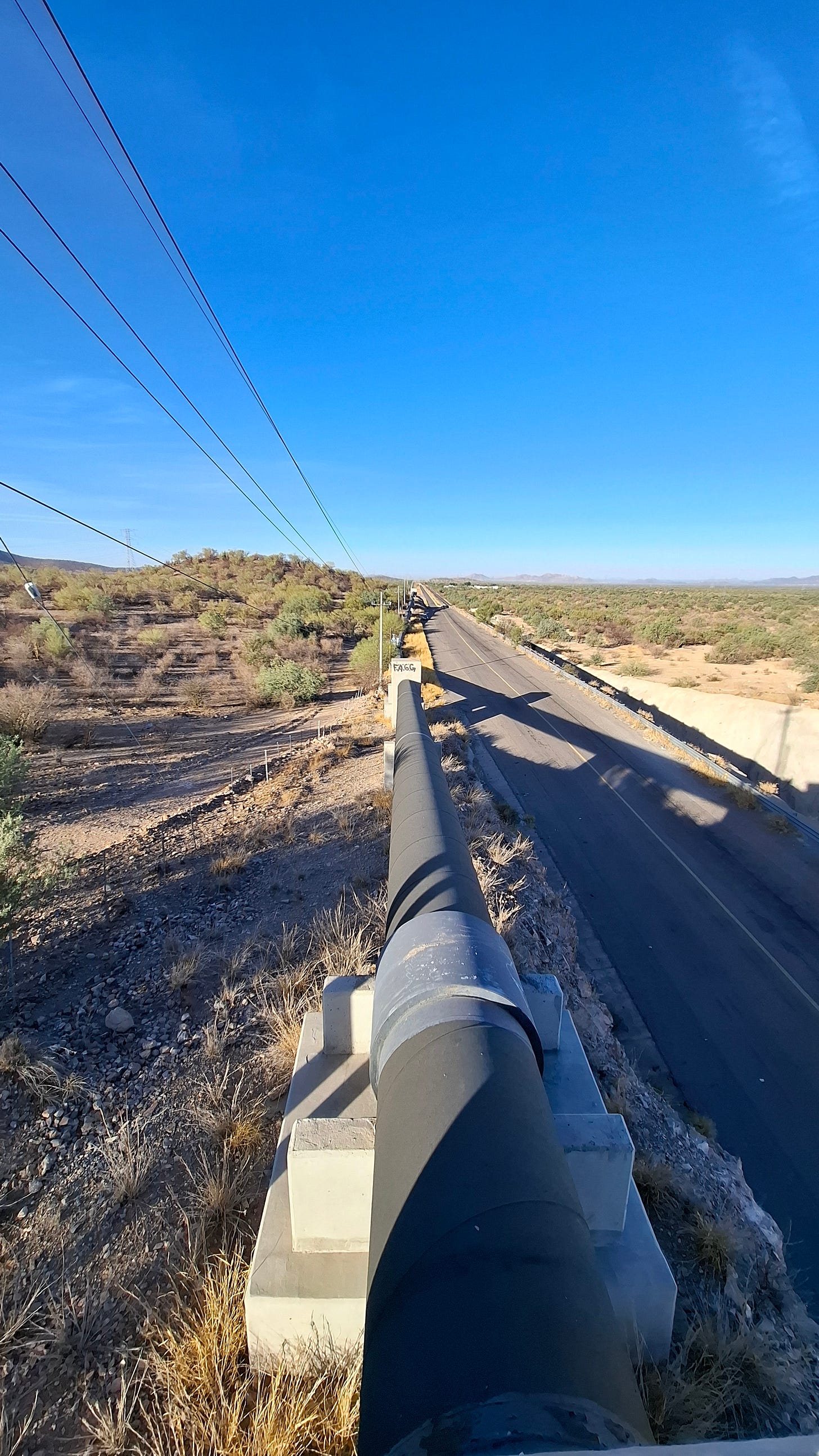Like the arid U.S. Southwest, northwest Mexico faces an acute water crisis. In recent months, the country’s federal water commission (CONAGUA), Sonora’s state water commission, and the water utility of the city of Hermosillo have proposed building three new dams on the Sonora River, which is already stretched thin by agricultural, urban, and industrial demands—and which was the site of a mining disaster in 2014 that never saw full remediation. In this essay, Diego Rodríguez Landeros traces the waters of the state’s Río Yaqui and Río Sonora through the existing dams and aqueducts that shape their flows.
Telling the Stories of Sonora’s Water
“All water carries stories, voices, and drowned towns. To narrate what happens in a basin, you have to follow its waters’ full course.” An essay by Mexican writer Diego Rodríguez Landeros.
Translated by Caroline Tracey
In December 2023 I spent two weeks in the city of Hermosillo for the 18th birthday of my goddaughter, Jana. One Friday night, my compadres Jano and Osiris took me to Club Obregón, one of the best bars in northwest Mexico. There, surrounded by a hundred other people, we jumped and spun around the open-air dance floor as the band Nibel 70 played the song “Viva Tepupa,” the number that most got the crowd going.
Later, my compadres and I returned to our table to pour ourselves some more Tecate. Knowing I enjoy stories about water, they told me the story behind the song. It’s about Tepupa, one of three villages in Sonora that were flooded at the end of the 1960s by the Plutarco Elías Calles hydroelectric dam, better known as El Novillo (the bull).
Sensing my enthusiasm, before I left my compadres gave me a copy of the 2023 novel Nosotras by Suzette Celaya Aguilar. Born in Hermosillo in 1982, Celaya Aguilar uses literary fiction as a lens through which to examine the forced displacement of the residents of the towns of Tepupa, Suaqui, and Batuc after El Novillo was filled.
Narrated in the first person across 27 chapters, the novel tells the story of Violeta, a young woman spiritually trapped in a morbid triangle formed by her grandmother, mother, and daughter, all dead. She inherits the family home, located in the upper part of the town—unnamed, and therefore encompassing Tepupa, Suaqui, and Batuc—which is about to be inundated. To create a chorus that complements Violeta’s perspective, Celaya Aguilar intersperses the chapters with images of or dialogues about places and people in the town.
What had until recently been normal life becomes radically distorted in the urgency of evacuation. Government agents persuade most neighbors to accept a payout for their homes, promising that it will suffice for them to establish themselves in the city. This forced rural-to-urban migration compounds another ongoing displacement spurred by the United States’ Bracero Program. The agents’ demagogic rhetoric goes like this: if people leave their traditional ways of life, they will contribute to the region’s progress and enjoy its benefits—because, of course, the dam will generate electricity and provide them with Light, in uppercase, that myth of Modernity that often takes the form either of a deity or, in Mexico, of the institutional force of nature known as the Federal Electricity Commission.
Many accept and soon depart. Gradually, like a leaking cistern, the town is emptied, taking on a ghostly quality reminiscent of a Juan Rulfo novel. The previously well-oiled machine of social tensions grinds into a theater of tormented skulls—there’s an entire chapter dedicated to the exhumation of cadavers from the local cemetery.
Those who remain warn that the payout is unfair and negotiate with authorities who grow more macabre by the day. The impending apocalypse of the flood affects each person’s psyche in different ways: some commit murder, while others succumb to lust, drunkenness, denial, cynicism, or simple boredom, like Javier, who spends his days trapping venomous snakes just “to have something to do” before the water comes. Social conventions become relative, and moral institutions lose all significance. Family histories of abuse resurface moments before they are submerged for eternity. Without the police or the church, it’s a time for crime and revenge, but also for alliance and reconciliation.
I read on the jacket of Nosotras that the author also wrote a master’s thesis in social science titled “Lo que El Novillo se llevó,” or “What El Novillo Took.” I wonder what a literary work can convey that an academic one cannot. I revisit the novel and appreciate its important dimensions of delirium, the symbolic apparitions that elude the causal chain of historical facts yet imbue those facts with meaning, making them transmissible through narration and legend. Fiction commits itself to magic in conjuring the story of Violeta, who remains in the village after everyone else has left and, once the waters arrive, transforms into a tree that awaits another spring despite all the death that surrounds it.
The verifiable history is that, from the end of the 1960s to 2013, the El Novillo dam, located in the Río Yaqui basin and operated by Mexico’s Federal Electricity Commission, held back water to generate energy for the region. In that basin, there are three dams managing the river’s waters in distinct ways. The uppermost and oldest is La Angostura, which, under a decree dating to the presidency of Lázaro Cárdenas (1934–40) that remains in force, must provide 50 percent of its water for human and agricultural consumption by Yaqui communities. In practice, however, it mainly serves as storage for the many mining companies operating in the Sierra Madre Occidental. The second dam is El Novillo. The third, called Oviáchic, caters to the big agribusiness companies in the valley and, since 2020, to the immense beer-bottling plant Constellation Brands, which relocated to Ciudad Obregón after being expelled from Mexicali, Baja California, by the collective Mexicali Resiste in 2019, over its contribution to the Colorado River basin’s water crisis.
Since 2013 much of the water covering the ruins of Tepupa, Suaqui, and Batuc in the El Novillo reservoir has been diverted to the Abelardo L. Rodríguez reservoir in the Río Sonora basin, in an effort to mitigate the effects of drought and ensure a water source for the city of Hermosillo. In engineering terms, this transfer from the Río Yaqui basin to the Río Sonora basin occurs via a 90-mile-long tube, 52 inches in diameter, called the Acueducto Independencia. Thanks to two electric pumping stations, it theoretically moves 60,000 acre-feet of water each year. Seen from another angle, the interbasin transfer is a materialization of the state’s illegal operations, favoring certain social sectors—the corporate and urban—at the expense of marginalized ones: Indigenous communities and low-income urban and rural communities.
The Yaqui tribe learned about the construction of the Acueducto Independencia through media coverage after the project had already been approved by the state, without any consultation—despite the presidential decree affirming their right to the water. Tribe members filed a legal challenge before Mexico’s supreme court, which “canceled the Aqueduct’s Environmental Impact Statement Authorization due to violating the right to consultation.” With the court’s support, the Yaquis maintained intermittent roadblocks for several years as a form of protest. Nevertheless, the aqueduct was ultimately constructed despite the law. “Against all legal logic, it was inaugurated in 2013 and began operations despite judicial orders pointing out its irregularities.”
The immediate consequence was that the lower part of the basin, home to the eight traditional Yaqui pueblos, dried up. The river has not flowed through those lands for years—though that doesn’t mean there isn’t water. The liquid from El Novillo that isn’t sent to Hermosillo via the Acueducto Independencia and that remains in the Río Yaqui basin ends up in the Oviáchic reservoir, channeled to flow like capital toward the valley’s agribusinesses, Constellation Brands, and Ciudad Obregón. The water from El Novillo that is transferred to Hermosillo also primarily serves the city’s industries. As a secondary priority, it is distributed among residents, who receive it in strict rations at certain hours—or not at all, relying instead on buckets and delivery trucks. Meanwhile, the Ford automotive factory in Hermosillo consumes 17 million gallons of water each month, according to an article published online by the company itself.
Here, the waters and histories mix. From what I saw, on Friday nights it’s common to find workers from the Ford factory at Club Obregón. That night, we were all drinking beer and dancing. It’s likely that in their homes—like in that of my compadres—the water supply is limited. Meanwhile, the Cuahtémoc Moctezuma brewery operates two plants in northwest Mexico: one in Navojoa, Sonora, and another in Tecate, Baja California. To produce a liter of beer, you need three to five liters of water. The imminent apocalypse affects each psyche differently, but even in Mad Max, we humans continue our dance of death. Long live Tepupa!
In addition to the Acueducto Independencia, Hermosillo receives water from the Río Sonora basin via the El Molinito dam. On August 6, 2014, environmental disaster struck the river. One of Grupo México’s mines spilled 14 tons of copper sulfate into the Río Bacanuchi, a tributary of the Río Sonora, as it passed through the city of Cananea.
In the aftermath of this disaster, the writer Gabriela Villa created the site http://www.georelatos.mx, which the writer Mónica Nepote later recommended to me. Georelatos shows a satellite view of the basin with nine marked points along the river: Cananea, Bacoachi, Arizpe (twice), Banámichi, Huépac, San Felipe de Jesús, Aconchi, Baviácora, and Ures. Each point leads the visitor to the text and audio of an illustrated short story, accompanied by drone footage of the site where the narration takes place. Most stories use the spill as their backdrop. In “El Ombligo” (The belly button), a mother speaks to her daughter after she has eaten mud from the river. There, I find another “nosotras”—echoing the title of Celaya Aguilar’s novel, though for me, it is not an “us” but an “ellas,” a “them”—that moves me:
The next day, they announced what had happened at the river, and suddenly I felt the weight of all my accumulated tiredness. Without turning off the radio, I got up to wash out my mouth with Zote soap. Although it didn’t seem like we would have any of what they said, I checked you over completely before heating up the water to bathe you. There was nothing to read into in your belly button. We share a root from within, I thought. You sing and I sing. Sometimes, we sing.
All water carries stories, voices, and drowned towns. To narrate what happens in a basin, you have to follow its waters’ full course.
Read this essay in Spanish at Casa del Tiempo.
 Read more: Read More
Read more: Read More







